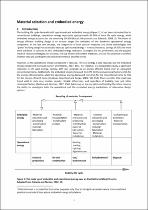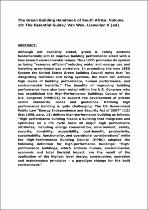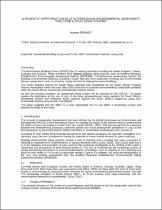JavaScript is disabled for your browser. Some features of this site may not work without it.
- ResearchSpace
- →
- Research Publications/Outputs
- →
- Book Chapters
- →
- View Item
| dc.contributor.author |
Ampofo-Anti, N

|
|
| dc.date.accessioned | 2012-04-24T13:00:52Z | |
| dc.date.available | 2012-04-24T13:00:52Z | |
| dc.date.issued | 2010-11 | |
| dc.identifier.citation | Ampofo-Anti, N. 2010. Material selection and embodied energy. Green Building Handbook South Africa: the essential guide, volume 3. Alive2green. 10pp | en_US |
| dc.identifier.isbn | 978-0620-4524-03 | |
| dc.identifier.uri | http://hdl.handle.net/10204/5822 | |
| dc.description | Copyright: 2010 Alive2green. | en_US |
| dc.description.abstract | The building life cycle demands both operational and embodied energy. It has been estimated that in conventional buildings, operational energy represents approximately 80-90% of total life cycle energy, while embodied energy accounts for the remaining 10-20%. The intent of energy efficient building design is to directly target the reduction of the dominant operational energy component. In the last two dacades, the intergration of both passive measures and active technologies into "green" building design has drastically reduced operational energy - in many instances, savings of 50% and more were achieved. In contrast to this, embodied energy reduction strategies are less prominent, and the popular material resources strategies, for instance, the use of recycled content materials, are also not assessed to confirm whether they are yielding the desired environmental benefits or not. | en_US |
| dc.language.iso | en | en_US |
| dc.publisher | Alive2green Publishers | en_US |
| dc.relation.ispartofseries | Workflow;5909 | |
| dc.subject | Green building handbook volume 3 | en_US |
| dc.subject | Building material | en_US |
| dc.subject | Embodied energy analysis | en_US |
| dc.subject | Building life cycle | en_US |
| dc.subject | Sustainable buildings | en_US |
| dc.subject | Energy efficient buildings | en_US |
| dc.subject | Green buildings | en_US |
| dc.subject | Recycled building materials | en_US |
| dc.title | Material selection and embodied energy | en_US |
| dc.type | Book Chapter | en_US |
| dc.identifier.apacitation | Ampofo-Anti, N. (2010). Material selection and embodied energy., <i>Workflow;5909</i> Alive2green Publishers. http://hdl.handle.net/10204/5822 | en_ZA |
| dc.identifier.chicagocitation | Ampofo-Anti, N. "Material selection and embodied energy" In <i>WORKFLOW;5909</i>, n.p.: Alive2green Publishers. 2010. http://hdl.handle.net/10204/5822. | en_ZA |
| dc.identifier.vancouvercitation | Ampofo-Anti N. Material selection and embodied energy.. Workflow;5909. [place unknown]: Alive2green Publishers; 2010. [cited yyyy month dd]. http://hdl.handle.net/10204/5822. | en_ZA |
| dc.identifier.ris | TY - Book Chapter AU - Ampofo-Anti, N AB - The building life cycle demands both operational and embodied energy. It has been estimated that in conventional buildings, operational energy represents approximately 80-90% of total life cycle energy, while embodied energy accounts for the remaining 10-20%. The intent of energy efficient building design is to directly target the reduction of the dominant operational energy component. In the last two dacades, the intergration of both passive measures and active technologies into "green" building design has drastically reduced operational energy - in many instances, savings of 50% and more were achieved. In contrast to this, embodied energy reduction strategies are less prominent, and the popular material resources strategies, for instance, the use of recycled content materials, are also not assessed to confirm whether they are yielding the desired environmental benefits or not. DA - 2010-11 DB - ResearchSpace DP - CSIR KW - Green building handbook volume 3 KW - Building material KW - Embodied energy analysis KW - Building life cycle KW - Sustainable buildings KW - Energy efficient buildings KW - Green buildings KW - Recycled building materials LK - https://researchspace.csir.co.za PY - 2010 SM - 978-0620-4524-03 T1 - Material selection and embodied energy TI - Material selection and embodied energy UR - http://hdl.handle.net/10204/5822 ER - | en_ZA |









